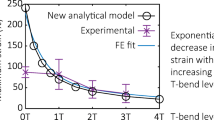We analyze the mathematical and methodical errors made by researchers in finding residual stresses in the coatings by the method of bending of plates proposed by methodical recommendations. New formulas are proposed on the basis of the model according to which stresses decrease across the thickness of the coating as the distance from the metallic substrate increases. It is shown that, contrary to the methodical recommendations, for the correct prediction of residual stresses in the coatings on actual products, it is necessary to restrain laboratory plates on both sides after deposition of the coatings and leave them straight until the complete polymerization (polycondensation) or drying of the material of the coating.
Similar content being viewed by others
References
N. I. Koryakina, Testing of Lacquer Materials and Paint Coatings [in Russian], Khimiya, Moscow (1988).
M. Ya. Popereka, Internal Stresses in Electrolytically Deposited Metals [in Russian], Zapadno-Sibirskoe Knizhnoe Izdatel’stvo, Novosibirsk (1968).
G. G. Stoney, “The tension of metallic films deposited by electrolysis,” Proc. of the Royal Society of London, Ser. A, Math. Phys. Char., 82, No. 533, 172–175 (1909).
A. T. Sanzharovskii, Methods for the Determination of Mechanical and Adhesive Properties of Polymeric Coatings [in Russian], Nauka, Moscow (1974).
S. P. Timoshenko, A Course of Strength of Materials [in Russian], Gostekhizdat, Moscow (1960).
I. A. Birger, Residual Stresses [in Russian], Mashgiz. Moscow (1963).
S. M. Holotenko, E. M. Kal’ba, R. T. Harmatyk, and O. S. Holotenko, “Influence of dispersed fillers on the adhesive and strength properties of polymeric composites,” Nauk. Notat., Issue 20, 89–95 (2007).
TU UV.2.7-24.6-13803953-001:2006, Organosilicon Insulating Coating for Tubes with Diameters Varying Within the Range 57–1420 mm, Fittings, and Connections [in Ukrainian], “Tekhno-Resurs” DPITs, Lviv (2006).
Author information
Authors and Affiliations
Corresponding author
Additional information
Translated from Fizyko-Khimichna Mekhanika Materialiv, Vol. 45, No. 5, pp. 124–130, September–October, 2009.
Rights and permissions
About this article
Cite this article
Gnyp, I.P., Voloshyn, M.P. Specific features of the determination of residual stresses in paint coatings by the method of bending of plates. Mater Sci 45, 751–758 (2009). https://doi.org/10.1007/s11003-010-9240-1
Received:
Published:
Issue Date:
DOI: https://doi.org/10.1007/s11003-010-9240-1




